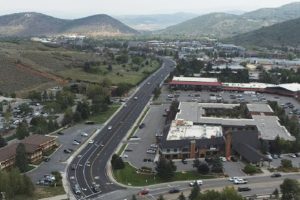Global climate experts have been interested in emissions and their connection to climate change for decades. That interest has caused a shift toward extremely specific actions. As a result, the asphalt industry’s customers want to use low-carbon materials more and more, and the clean policies being written reflect that.
NAPA created The Road Forward program after more than a year of preparation by a 21-member Climate Stewardship Task Force. The program is important: one article compared the initiative to the construction of the Interstate Highway System in the 1950s and 1960s.
NAPA hopes The Road Forward’s vision will galvanize the industry.
The Road Forward program was released at NAPA’s Annual Conference, held in January 2022 in Scottsdale, Arizona. It includes four goals, nineteen tactics to help achieve each goal, and eight knowledge gaps involving the research and implementation needed to succeed. The group studied what the industry is currently doing, identified opportunities for improvement, and set an ambitious goal: net-zero carbon emissions by 2050.
Although large parts of The Road Forward program should sound familiar, such as using more Reclaimed Asphalt Pavement (RAP) and Warm Mix Asphalt (WMA) technologies, the overall goals are much broader in scope than just using more RAP and reducing mix production temperatures.
The program’s four goals are as follows:
- Achieve net-zero carbon emissions during asphalt production and construction by 2050
- Partner with customers to reduce emissions through pavement quality, durability, longevity, and efficiency standards by 2050
- Develop a net-zero materials supply chain by 2050
- Transition to electricity from renewable energy providers to support net zero-carbon electricity by 2050 and reduce electrical intensities
The stated mission of the plan is to “Engage, educate, and empower the U.S. asphalt community to produce and construct net-zero carbon emission asphalt pavements.” The stated vision is: “Sustainable communities and commerce, connected by net-zero carbon emission asphalt pavements.”
In short, the plan states that human forces, the free market, and governments are aligning to reduce carbon emissions by injecting policies and practices into business models. NAPA leaders believe that, over the next several decades, reducing carbon emissions will be the industry’s foremost goal, persisting even amid changing political or economic situations.
NAPA also has guidance about developing Environmental Product Declarations (EPDs) to help the asphalt industry prepare for new bidding requirements. A completed EPD is 11 pages long and quantifies the embodied carbon emissions and other environmental impacts such as acid rain-caused emissions and smog. Joseph Shacat, NAPA’s director of sustainable pavement, spoke with UAPA about EPDs and The Road Forward. “It doesn’t matter what state you live in. We are moving into an era where agencies at some level will be looking at these issues. It isn’t abstract anymore. The train is leaving the station, and the question is, are we going to be at the terminal wondering what happened? Or are we going to have a ticket to get on that train?”
According to Mr. Shacat, the real value of The Road Forward program is the way it sets out long-range goals for the industry and stays ahead of the curve. “This program is moving us in the direction our industry’s customers are going to want over the coming year,” he said. “We are starting to see what states and agencies are looking for. The federal government is launching a ‘buy clean’ program directly targeted at asphalt and concrete, and the government recently asked the industry to brainstorm by issuing a Request for Information (RFI) that was due at 6 p.m. March 1, 2022.” The RFI is about asphalt, and it is formally called Environmental Product Declarations and Sustainable or Low Embodied Carbon Products.
Emissions can be categorized as embodied or operational. Embodied emissions occur during manufacturing, and operational emissions occur when a product is being used. For example, embodied emissions occur when a manufacturer builds a vehicle, and operational emissions occur once the vehicle is on the road. The same is true for road construction: emissions that occur from the manufacturing of raw materials, asphalt mix production and paving are embodied. The emissions that occur after a road has been paved with asphalt are operational.
Joseph Shacat said, “What we are seeing is that agencies at the federal, state, and local level are beginning to require contractors to submit EPDs because they want to know what the environmental impact is of the products they purchase. Once a government organization has the report, the organization can require or incentivize lower emissions on projects.“
After gathering specific information about each company, the RFI asked about seven areas of interest. The first was cradle-to-gate EPDs for asphalt mixes: how they are generated, whether there is any non-EPD documentation, and whether EPDs have attracted business customers. The second was the question of market demand for low embodied carbon asphalt and what strategies are being used to reduce carbon emissions, such as EPDs, and whether the responding company has a dedicated or specialized sustainability staff.
The third RFI question pertained to companies producing or supplying low embodied carbon asphalt, and the production details and cost comparisons about innovative or outstanding environmental attributes, and the performance attributes associated with manufacturing, installing or using asphalt. The fourth question was about obstacles (technical, economic, or regulatory) and for suggestions about reducing asphalt manufacturing’s carbon footprint.
The final three questions related to product testing, states using environmentally preferable asphalt, and the location of asphalt plants. They wanted to know about challenges, implementation lessons and best practices when using environmentally-preferable asphalt. They also wanted to know if mobile plants are used at remote sites and if the company could recycle pavement on-site.
Richard Willis, Ph.D., NAPA’s vice president for engineering research and technology, attended the Utah Asphalt Conference 2022, held Feb. 1-2, 2022, at Mountain America Expo Center. While there, he also presented about EPDs. UAPA contacted him after the conference to talk about EPDs and The Road Forward. He said, “The Road Forward presents an opportunity for contractors in Utah and throughout the country to become better businesses. The program allows everyone to look holistically at how their businesses are positively affecting the community.”
Mr. Willis and Mr. Shacat are part of the task force leadership that produced The Road Forward program. The plan’s details can be found at asphaltpavement.org/climate.






